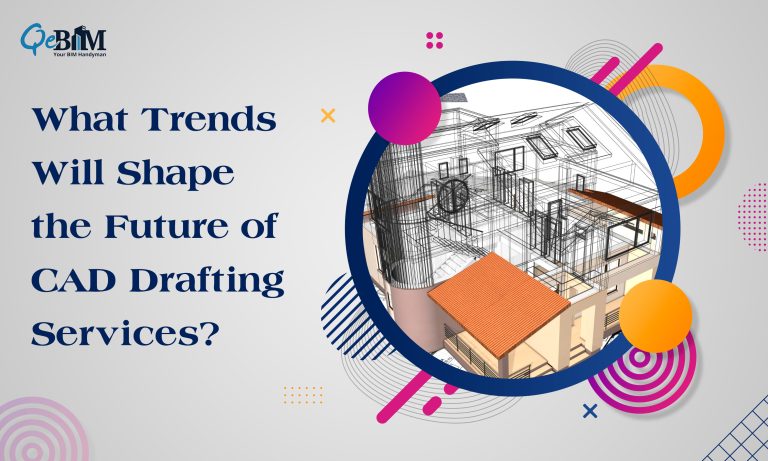What Trends Will Shape the Future of CAD Drafting Services?

In the world of design and engineering, CAD has revolutionized the way many products are conceptualized, developed, and brought to the life. Over many years, CAD Services have evolved tremendously, keeping the pace with the technological advancements in this sector as well as industry demands. When we step ahead and look in to the future of CAD Drafting Services, it promises to be even more transformative that is driven by innovation, automation, and the integration of advanced and cutting-edge technologies.
In this article, we will look into some of the most prominent trends shaping the future of CAD drafting services.
Watch out the Upcoming Trends in CAD Drafting
1) AI and Machine Learning Integration: One of the most significant advancements in CAD drafting services is the incorporation of Artificial Intelligence (AI) and Machine Learning (ML). These technologies have the sure short potential to revolutionize the design processes by automating all the repetitive tasks thereby optimizing the designs based on the data analytics, and even opting for generating design alternatives. AI-powered CAD software is known well to analyse vast amounts of data, learn from the past designs, and also provide great valuable insights to the designers. This in turn leads to quite faster iterations as well as more efficient workflows.
2) Generative Design: Generative design does take CAD drafting to a whole new level by leveraging the algorithms to explore numerous design iterations based on some specified constraints as well as objectives. This approach is however proven to allow the designers to generate more innovative solutions that might not be immediately apparent through the traditional methods. By using the power of generative design, CAD drafting services can produce optimized designs that are quite lighter, stronger, and more efficient. They also lead to a more cost-friendly yet improved performance across various industries.
3) Cloud-Based Collaboration: The future of CAD drafting services lies in the seamless collaboration enabled by the cloud-based platforms. These platforms allow multiple stakeholders like designers, engineers, clients, as well as manufacturers, to collaborate in real-time regardless of their location. Cloud-based CAD software offers numerous benefits such as version control, instant updates, and centralized data storage. This however fosters the efficiency, productivity, and agility in the design process to a greater extent.
4) Virtual and Augmented Reality: VR and AR are revolutionizing the way many designers do interact with the CAD models. It allows with immersive experiences that enhance visualization as well as quicken the decision-making. VR allows designers to step into the virtual environments and explore their design iterations at a human scale, while AR is known to overlay the digital information onto the physical world, facilitating the design reviews as well as onsite inspections. Therefore, integrating both VR and AR into CAD drafting services enhances communication, reduces errors, and accelerates the design validation process.
5) Parametric Modeling and 3D Printing: Parametric modeling allows the designers as well as architects to create an intelligent yet adaptive models that can be easily modified and updated as and when the project requirements evolve. When we combine 3D printing technology with the parametric modelling, it opens up many new possibilities for the rapid prototyping and iterative designs. CAD drafting services can leverage parametric modeling to create complex geometries as well as intricate designs that push the boundaries of innovation across various industries, from architecture to aerospace.
6) Sustainability and Green Design: With growing concerns relevant to the climate change along with the environmental sustainability, CAD drafting services are increasingly focusing on the green design principles. The sustainable design practices however aim to minimize the environmental impact of products and buildings by optimizing the energy efficiency thereby reducing the wastes and incorporating the renewable materials. CAD software equipped with sustainability analysis tools allows the designers to evaluate the environmental performances of their designs and to make informed decisions that prioritize sustainability without compromising on the functionality or the aesthetics.
7) Blockchain for Intellectual Property Protection: With intellectual property rights becoming increasingly important in the digital age, the blockchain technology is found to be emerging as a potential solution for protecting the design assets as well as ensuring the traceability and authenticity. By leveraging the blockchain technology, CAD drafting services can create immutable records of design ownership, track revisions along with permissions, and also prevent unauthorized use or infringement. The blockchain-powered platforms offer enhanced security and transparency thereby safeguarding the intellectual property rights of many designers and stakeholders throughout the design lifecycle.
8) Customization and Personalization: In today’s consumer-driven market, customization and personalization are the key differentiators for product design and development. CAD drafting services are continually evolving to meet the demand for the bespoke solutions tailored to the individual preferences as well as requirements. Right from customizable furniture designs to the personalized medical devices, CAD software allows the designers to create unique products that resonates well with their target audience, driving customer satisfaction and also the brand loyalty.
Concluding:
The future of Drafting Services is filled with promise and innovation. It is definitely fuelled by the advancements in technology, changing industry dynamics, as well as evolving design paradigms. Right from AI-driven automation to the sustainable practices and immersive experiences, the scenario of CAD drafting is undergoing a profound transformation. By watching and implementing out these future trends, designers and engineers can unlock new possibilities in this industry by streamlining the workflows and curating the designs that will shape the world of tomorrow. As we step into the future of architecture, design and construction, one thing is certain: the only limit to what CAD drafting services can achieve is our imagination.